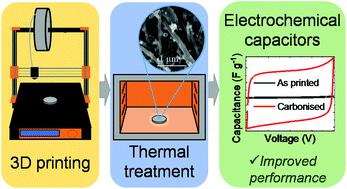Our official English website, www.x-mol.net, welcomes your feedback! (Note: you will need to create a separate account there.)
Tailoring capacitance of 3D-printed graphene electrodes by carbonisation temperature.
Nanoscale ( IF 6.7 ) Pub Date : 2020-09-23 , DOI: 10.1039/d0nr04864j Edurne Redondo 1, 2, 3, 4, 5 , Siowwoon Ng 1, 2, 3, 4, 5 , Jose Muñoz 1, 2, 3, 4, 5 , Martin Pumera 1, 2, 3, 4, 5
Nanoscale ( IF 6.7 ) Pub Date : 2020-09-23 , DOI: 10.1039/d0nr04864j Edurne Redondo 1, 2, 3, 4, 5 , Siowwoon Ng 1, 2, 3, 4, 5 , Jose Muñoz 1, 2, 3, 4, 5 , Martin Pumera 1, 2, 3, 4, 5
Affiliation

|
3D-printing is an emerging technology that can be used for the fast prototyping and decentralised production of objects with complex geometries. Concretely, carbon-based 3D-printed electrodes have emerged as promising components for electrochemical capacitors. However, such electrodes usually require some post-treatments to be electrically active. Herein, 3D-printed nanocomposite electrodes made from a polylactic acid/nanocarbon filament have been characterised through different carbonisation temperatures in order to improve the conductivity of the electrodes via insulating polymer removal. Importantly, the carbonisation temperature has demonstrated to be a key parameter to tailor the capacitive behaviour of the resulting electrodes. Accordingly, this work opens new insights in advanced 3D-printed carbon-based electrodes employing thermal activation.
中文翻译:

通过碳化温度调整3D打印石墨烯电极的电容。
3D打印是一项新兴技术,可用于对具有复杂几何形状的对象进行快速原型制作和去中心化生产。具体而言,碳基3D打印电极已成为电化学电容器的有希望的组件。然而,这样的电极通常需要一些后处理才具有电活性。从聚乳酸/纳米碳长丝在本文中进行,3D印刷纳米复合物电极已在为了提高电极的导电率的特点,通过不同的碳化温度下通过绝缘聚合物的去除。重要的是,碳化温度已证明是调整所得电极的电容性能的关键参数。因此,这项工作为采用热激活的高级3D打印碳基电极开辟了新的见解。
更新日期:2020-10-08
中文翻译:

通过碳化温度调整3D打印石墨烯电极的电容。
3D打印是一项新兴技术,可用于对具有复杂几何形状的对象进行快速原型制作和去中心化生产。具体而言,碳基3D打印电极已成为电化学电容器的有希望的组件。然而,这样的电极通常需要一些后处理才具有电活性。从聚乳酸/纳米碳长丝在本文中进行,3D印刷纳米复合物电极已在为了提高电极的导电率的特点,通过不同的碳化温度下通过绝缘聚合物的去除。重要的是,碳化温度已证明是调整所得电极的电容性能的关键参数。因此,这项工作为采用热激活的高级3D打印碳基电极开辟了新的见解。



























 京公网安备 11010802027423号
京公网安备 11010802027423号